Abstract
Zinc Oxide Nanoparticles (ZnONPs) are one of the most widely used metal oxide nanoparticles in biological applications because of their outstanding biocompatibility, affordability, and low toxicity. In biomedicine, ZnONPs have shown promise, particularly in the disciplines of anticancer and antibacterial fields. In comparison to other standard synthesis methods, the environmentally-friendly synthesis of metallic nanoparticles utilizing various plant extracts is a good option. The current research focuses on the synthesis of zinc oxide nanoparticles (ZnONPs) from R. sativus leaf extract under various physical conditions (Precipitation method). Analytical methods were used to confirm and characterize the produced ZnONPs. The spherical nature of the produced nanoparticles was established by SEM analysis. The generation of very pure ZnONPs was confirmed by EDS data. The crystalline nature of the produced nanoparticles, with a particle size of 66.47 nm, was confirmed by XRD. The XRD graphs’ presence of the (100), (002), and (101) planes strongly suggest the production of wurtzite ZnO. The visual and infrared area exhibits transmissions of 84 percent in the pH 10 nanoparticles. The band gap of the nanoparticles increases from 3.34 to 3.38 eV when the pH increases. These nanoparticles were effective against both Gram-positive and Gram-negative bacteria. The effect of several process parameters such as pH and temperature were investigated, and the best conditions were discovered to be pH 12 and 80 °C, respectively. The effect of ZnONPs was tested with human breast cancer cells (MCF-7), and they showed significant cytotoxic results. Collectively, our data suggest that ZnONPs of R. sativus leaf extract inhibit breast cancer cell lines. The ZnONPs are, therefore, a prospective source of chemopreventive drugs that merit additional exploration in order to uncover lead compounds with cancer chemotherapeutic potential.
1. Introduction
The popular discipline of nanotechnology makes a number of claims in the physical, biological, and agricultural sciences [1,2]. A fascinating area of nanotechnology study is the creation of nanoparticles. In recent years, numerous researchers have become interested in various metal nanoparticles, including silver, iron, copper, and zinc [3,4]. The numerous techniques for physical and chemical synthesis, including laser ablation, sol-gel method, co-precipitation, thermal decomposition, microwave irradiation, inert gas condensation, and sono-chemical synthesis, are costly, toxic, and time-consuming. Therefore, the drawbacks of conventional techniques can be solved by using green synthesis to create metallic NPs. In comparison to traditional approaches, the green synthesis of metallic NPs from diverse plant extracts has emerged as a superior alternative. Zinc oxide nanoparticles (ZnONPs) have drawn the most interest among the various metal oxide nanoparticles due to their remarkable optical and chemical characteristics. ZnONPs find various biotechnological applications such as drug delivery, gene delivery, biological labeling, nanomedicines, and biological sensing.
Numerous researchers have documented the environmentally friendly manufacture of ZnONPs utilizing various plant extracts, including Calotropis gigantean [5], Ocimumbasilicum L. var. Purpurascens [6], Corymbia citriodora [7], Cassia tora L. [8], Sageretiathea [9], and Anisochilus carnosus [10], Zingiber officinale [11], Azadirachta indica [12], Hibiscus rosa-sinensis [13]. Since they do not contain any hazardous chemicals and function as a natural stabilizing, reducing, and capping agent, many plants and their parts have evolved into a superior platform for the production of nanoparticles. According to the literature study [14], not much has been undertaken to utilize the antibacterial characteristics of Raphanus sativus (commonly known as radish) leaves in the production of ZnONPs. Various researchers have reported that R. sativus possess anticancer, antioxidant, antimicrobial, antiviral, and antitumor properties. In India, the leaves of R. sativus are often discarded as waste or utilized as animal feed [15,16]. As a novel low-cost and low-toxic nanomaterial, ZnONPs have generated a great deal of interest in a variety of biomedical applications, including anticancer, antibacterial, antioxidant, as well as drug transport and bioimaging applications.
The current study focuses on the environmentally-friendly synthesis of ZnONPs, their characterization, and their use as an antibacterial agent while considering the requirement for global solid waste management and an environmentally favorable approach.
2. Resources and Techniques
2.1. Chemical Used
The leaves of the R. sativus plant were purchased from a reliable supplier. The chemicals employed were all of an analytical quality. HiMedia Laboratories Pvt Ltd., Mumbai, India, provided the media components used for the antibacterial test.
2.2. Phytochemical Analysis
The phytochemical analysis of an aqueous extract of R. sativus was conducted as per the earlier reported methods [17] for the presence of flavonoids (lead acetate test), alkaloids (Mayers test), tannins (gelatin test), saponins (Froth test), phenols (ferric chloride test), glycosides (Keller killiani test), protein (Biuret’s test) and amino acid (ninhydrin test), carbohydrates (Benedict’s test), and saponins (Froth test) [18].
2.3. Nanoparticles Synthesis
The nanoparticle’s surface chemistry, size distribution, particle shape, and particle reactivity in solution are some of the variables that affect how biologically active they are. For diverse biomedical applications, it is crucial to create nanoparticles with regulated structures that are consistent in size, shape, and functioning. The flowchart for the preparation of R. sativus leaf extract ZnONPs is depicted in Figure 1.
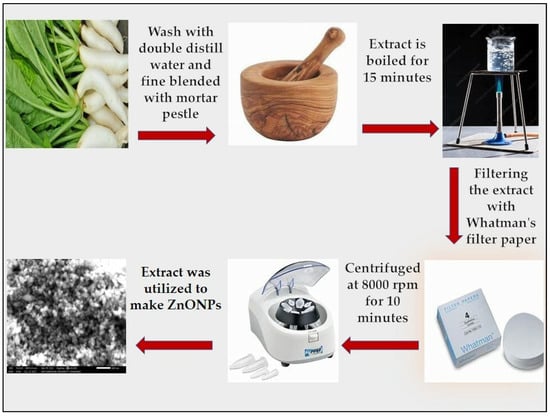
Figure 1.
Preparation of R. sativus leaf extract ZnONPs.
A wide range of properties will be offered by the ZnONPs, which are found in a very wide variety of sizes and shapes. In recent years, numerous techniques for creating stable ZnONPs have been discovered, most notably the chemical precipitation method.
Following steady stirring to solubilize the 0.1 M zinc acetate solution (Zn(O2CCH3)2(H2O)2), 20 mL of the plant extract was added dropwise to 80 mL of the zinc acetate solution. Freshly prepared 2 M NaOH was added dropwise to the solution while being gently stirred to move the pH level down to 10. The reaction mixture was then agitated with a magnetic stirrer for an additional two hours after being kept in a bath in water at 50 °C for one hour. To increase the pH to seven, a white crystalline precipitate was repeatedly rinsed with distilled water. To verify the synthesis of zinc oxide nanoparticles, the absorbance of the precipitate was measured by employing a 200–600 nm range in UV–Visible spectrophotometer (Shimadzu UV-1800 Spectrophotometer). The visual observation of the color change from yellow to pale, yellow-colored precipitate, as shown in Figure 2, provided preliminary confirmation of the creation of ZnONPs. Following precipitation, the product was dried at 50 °C.
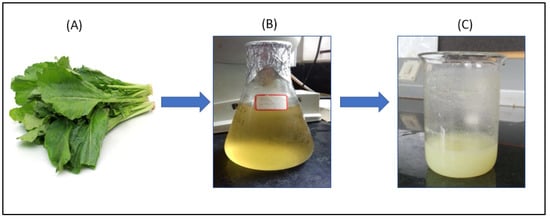
Figure 2.
Green synthesis of ZnONPs (A) R. sativus leaves, (B) Leaf extract, (C) ZnONPs.
2.4. Characterization of ZnO Nanoparticles
2.4.1. UV-Visible Spectroscopy
UV-Visible spectroscopy was employed to verify the creation of ZnONPs (Model-Shimadzu UV-1700, Kyoto, Japan).
2.4.2. SEM with EDS
The morphological evaluation of the ZnONPs was conducted using SEM (model: JSM-IT500 JEOL, USA).
2.4.3. FTIR
Fourier transform infrared spectroscopy was employed to determine the primary functional groups present in a variety of phytoconstituents and function as reducing and stabilizing agents in the formation of nanoparticles. The surface-binding characteristics of the synthesized ZnONPs were examined using FTIR. The ZnONPs sample was mixed with 10mg potassium bromide (KBr) was dried to eliminate moisture content. FTIR spectrum of the dried sample was obtained by using Nicolet FT-IR Spectrometer 5700.
2.4.4. XRD
A powder X-ray diffractometer was used to make the XRD measurements (Model- Rigaku Smart Lab SE). The scanning was performed for 2 min in the 20° to 80° range. Using Debye–Sherrer’s equation, the average particle size of the ZnONPs was determined.
2.4.5. Effect of pH and Temperature
The influence of several factors (temperature and pH) on the synthesis of ZnONPs was investigated. The different pH values (10, 11, 12, 13, and 14) were maintained using 2M NaOH. The reaction time, reaction mixture concentration, and reaction temperature were kept constant. The different temperatures ranging from 50 °C to 90 °C at intervals of 10 °C were maintained. Using a spectrophotometer, the UV-Visible absorbance of the solution was determined. The experiments were conducted in triplicate.
2.5. Antibacterial Activity
Three Gram-positive bacteria (Bacillus subtilis, Bacillus cereus, and Staphylococcus aureus) and three Gram-negative bacteria were tested for ZnONPs’ antibacterial activity (Escherichia coli, Pseudomonas aeruginosa, Zymomonas mobilis).
Gram-positive and Gram-negative bacteria were used to examine the agar-well diffusion method’s antibacterial capabilities with regard to the synthesized ZnONPs. For the antibacterial experiment, pre-poured sterile nutrient agar plates were employed. On the Petri plates, the bacterial test culture was seeded with overnight-grown cultures (1 × 105 CFU/mL). Then, 60 μL of a ZnO nanoparticle solution, 60 μL of distilled water, which served as a negative control, and 60 μL of a 30 g Linezolid disc, which served as a positive control, were all injected into 8 mm-diameter agar wells. Before being examined for the presence of zones of inhibition, the plates underwent an additional 24 h of incubation at 37 °C. The experiment was performed in triplicate, and the inhibitory zone was measured and expressed in millimeter units [19].
2.5.1. MTT Assay for Cytotoxicity
Overnight, the cells were kept in a vessel at 37 °C for a humid environment of 95% and 5% carbon dioxide. The plant extract (PE), AGNP nanoparticles, and positive control samples of various concentrations (100, 50, 25, 12.5, 6.25, and 3.125 μg/mL) were treated. Further Plate was incubated for another 48 h. Then, 20 L of the 3-(4,5-Dimethylthiazol-2-yl)-2,5-diphenyltetrazolium (MTT) staining solution was added to each well after the cells had been rinsed twice with phosphate buffer solution. The microplate was kept in the incubator at 37 °C for 4 h, and100 μL of DMSO was added to each well to dissolve the formazan crystals, and then it was used as a microplate reader to measure the absorbance at a wavelength of 570 nm.
Surviving cells (%) = Mean OD of test compound /Mean OD of Negative control × 100
2.5.2. Programmed Cell Death Assay by Flow Cytometer
The cells were first seeded in a 6-well flat-bottom microplate and incubated in CO2 overnight at 37 °C. The plant extract (PE) and AGNP nanoparticle samples were treated for 24 h to determine their IC50 values. The cells were twice rinsed in phosphate buffer solution (PBS) following incubation and then centrifuged at 500× g for 5 min at 4 °C. After discarding the supernatant, the ice-cold 1× binding buffer was combined with the cell pellets (1 × 106 per mL). After placing the tubes on ice, 5 L of Annexin V and 2 L of propidium iodide were added (PI). The tubes were gently combined. Additionally, the tubes were incubated for 15 min in the dark while being kept on ice. Then, 1× binding buffer at a volume of 400 L was added and thoroughly blended. The cell preparations were examined using FlowJo X 10.0.7 software and a Cytomics FC 500 Flow Cytometer (Beckman Coulter, Brea, CA, USA) in less than 30 min.
2.5.3. Cell Cycle Analysis
The cells were grown in a 6-well flat-bottom microplate and incubated with CO2 overnight at 37 °C. The plant extract (PE) and AGNP nanoparticle samples were treated for 12 h to determine their IC50 values. The cells were rinsed with phosphate-buffered solution (PBS) after incubation. The trypsinization was performed to collect the cells, and they were centrifuged for 5 min at 200× g at 4 °C, and then the supernatant was discarded. Then 1 × 105 cells were thoroughly resuspended in 0.5 mL PBS. Further, 4.5 mL of cold 70% ethanol was added, and the cells were kept fixative for 2 h on ice. The ethanol was completely decanted after the cells were centrifuged for 5 min at 200× g at 4 °C. After waiting for 60 s, the cell pellet was suspended in 5 mL of PBS. Later, 200× g centrifugation was carried out for 5 min at 4 °C. The supernatant was further decanted, and it was then resuspended for 15 min at 37 °C in 1 mL of propidium iodide staining solution. The cell preparations were examined by flow cytometry in less than 30 min.
3. Results and Discussion
3.1. Phytochemical Analysis
The study of the phytochemical analysis confirmed the presence of different phytoconstituents, which is shown in Table 1. The results show the presence of phenols and flavonoids in the plant extract, which are responsible for the green synthesis of metal oxide nanoparticles. These components act as stabilizing and reducing agents in the green synthesis of Zinc oxide nanoparticles, which is confirmed by the previous studies. The OH groups present in phenols and flavonoids can reduce and stabilize the zinc compounds into ZnO NPs [20,21].

Table 1.
Qualitative phytochemical screening of aqueous leaf extract of R. sativus.
3.2. Effect of pH
The green synthesis of the ZnONPs from the R. sativus leaf extract was performed at different pH and temperatures. The preliminary confirmation of ZnONP synthesis was observed by the change in color from yellow to pale yellow. The ZnONP synthesis was further confirmed by UV-Vis spectroscopy. The UV-Visible spectroscopy results showed a single peak at 367 nm due to intrinsic band gap absorption, which confirmed the synthesis of ZnONPs. From the UV-Visible spectra, it was observed that the ZnONPs are uniformly distributed. The literature review observed that different factors such as pH, temperature, the concentration of precursor, and the concentration of plant extract affected the surface plasmon resonance (SPR) bands [15]. While characteristic peak absorption was seen at 366 nm for pH 10 and 364 nm for pH 11, which suggested the formation of ZnONPs, no absorption peaks were seen at high pH between 12 and 14. The ZnONPs included free electrons, and it is possible that they will exhibit Surface Plasmon resonance (SPR) absorption bands at 370 nm, which will depict them as having an electron-rich metal surface (active surface). Intrinsic band gap absorption for ZnO is seen at 370 nm due to electron transitions from the valence band to the conduction band (O2p-Zn3d) [22,23]. The UV spectra of the produced NPs are given in Figure 3, and the distinctive peak at 366 nm in the UV region in pH 10 demonstrated that they are pure ZnO with a wurtzite hexagonal phase. The UV analysis from this study is comparable to earlier publications [24,25]. In this study, pH levels have a significant impact on the aging rates of nanoparticles. The final spherical nanoparticles’ shape and size distribution are determined by this parameter. In order to fully change Zn(OH)42− into ZnO, centrifugation separates the agglomeration of incompletely altered Zn(OH)42− and spins it.
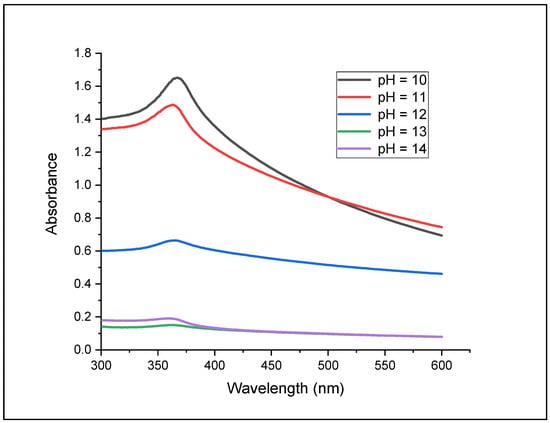
Figure 3.
UV-Vis Spectra showing the effect of pH on ZnO nanoparticle synthesis.
However, ZnO interacts with OH at greater OH concentrations or at pH 10, 11, 12, 13, and 14. According to this reaction [24], the dissolution of ZnO during the reverse reaction results in Zn(OH)42−:
ZnO + H2O + 2OH− → Zn (OH)42−
Small ZnO particles were created by the dissolution of bigger ZnO. In the meantime, an agglomeration is created when these tiny particles combine with Zn(OH)42−.
3.3. Effect of Temperature
The effect of temperatures on ZnONPs was observed, as shown in Figure 4. From the UV-Vis spectroscopic results, it was observed that there is no characteristic absorption band at lower temperatures of 60 °C and 70 °C; however, at higher temperatures of 80 °C and 90 °C, a sharp surface plasmon resonance (SPR) peak was observed at 380 nm. The higher the temperature, the greater the activation energy of the molecules, and the faster the rate of reaction, due to which there is a decrease in the size of the nanoparticles, and hence monodispersed smaller-sized nanoparticles are formed. It was found in the current investigation that with an increase in temperature, there is a decrease in the size of ZnONPs, which is evident from the sharp and narrow Surface Plasmon Resonance (SPR) peaks [16].
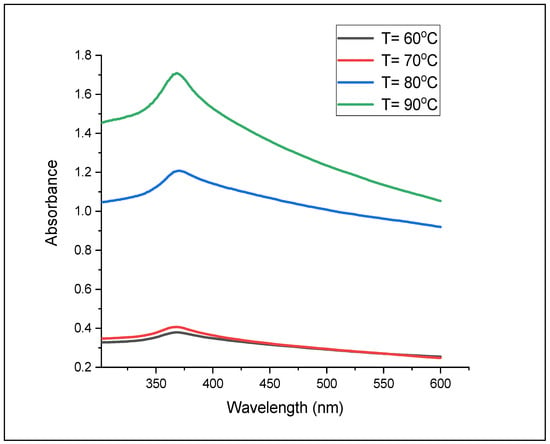
Figure 4.
UV-Vis Spectra showing the effect of temperature on ZnO nanoparticle synthesis.
The UV spectroscopy results obtained from the ZnONPs synthesized under different temperatures recorded peaks at 372.86 nm, 370.28 nm, 368.00 nm, and 365.55 nm for 60 °C, 70 °C, 80 °C, and 90 °C, respectively. The band gap energy (Ebg) of the ZnONPs was calculated using an equation and tabulated in Table 2. The calculated band gap value for 80 °C is 3.36 eV, which is the closest to the theoretical band gap value of 3.37 eV compared to other temperatures. It can be concluded that the temperature of 80 °C provides the best condition for the synthesis of ZnONPs [15,16,17,18].

Table 2.
The peak of the spectrum at different temperatures.
3.4. FTIR Spectral Analysis
FTIR is used to identify the different operative groups involved in the production of ZnONPs. As shown in Figure 5, the FTIR spectra showed several peaks at 3418.99, 2923.05, 1617.20, 1160.83, and 436.14 cm−1. The stretching vibration peaks for ZnO designated as metal oxides (M-O) were observed at 3418.99 cm−1, connected to the stretching vibration of the phenol or alcoholic group’s H-bonded hydroxyl (-OH) group, 2923.05 cm−1, related to N-CH3 groups with C-H stretching vibrations, 1617.20 cm−1, related to a carbonyl group (C=O) stretching bands, and 1160.83 cm−1, related to -C-O- The FTIR spectrum shows band shifts from their initial values, which could be the result of several functional groups present in the plant extract.
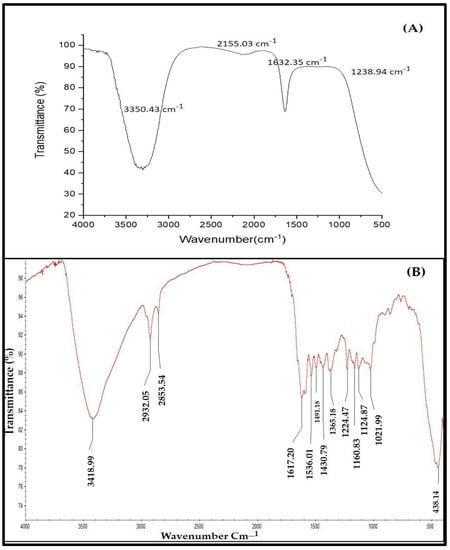
Figure 5.
FTIR Spectrum of (A) Raphanus sativus leaf extract (B) ZnONPs.
The inclusion of plant-extract flavonoids and phenols facilitates the conversion of metal ions to NPs. This is shown by the signal for carbonyl groups (C=O) at about 1617.20 cm−1 [15,16,17,18].
3.5. SEM Analysis
SEM reveals the NPs’ size, shape, and surface morphology. An SEM (model: JSM-IT500 JEOL, USA) was used to analyze the shape of NPs at various magnifications. According to the SEM analysis, the generated ZnONPs are spherical hexagonal in shape with uneven morphology and aggregated NPs. An SEM picture of various magnifications of the ZnONPs is presented in Figure 6 [15,16,17,18].
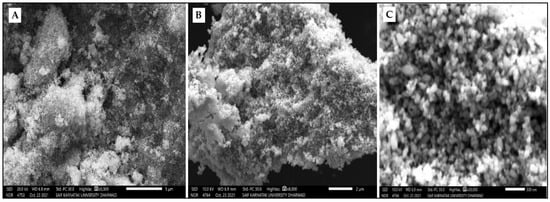
Figure 6.
SEM images of ZnONPs at magnifications of (A) 5000×, (B) 8000×, (C) 30,000×.
3.6. EDS Analysis
In Figure 7 and Table 3, the EDS spectra peaks for zinc (Zn), carbon (C), and oxygen (O) verified the presence of metallic zinc acetate in the synthesis of ZnONPs. These absorbance peaks are caused by the SPR of the ZnONPs. The presence of a trace amount of oxygen suggests that phytochemicals act as reducing, capping, and stabilizing agents in the synthesis of ZnONPs [15,16,17,18].
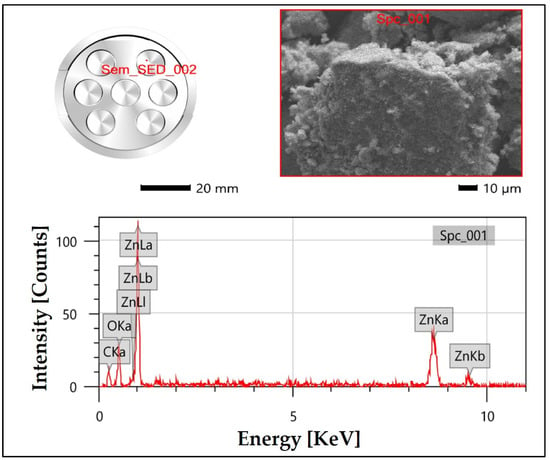
Figure 7.
EDS result of ZnONPs of leaf extracts of R. sativus showing measurement conditions.

Table 3.
EDS result of ZnONPs of leaf extracts of R. sativus showing fitting ratio.
3.7. XRD Analysis
The nanoparticles are studied using XRD, as shown in Figure 8, to determine their phases, structures, and crystal orientations. Diffraction patterns at 31.76, 34.40, 36.25, 47.52, 56.57, 62.82, 66.38, 67.91, and 69.04 degrees. They were successively attached to the lattice planes (100), (002), (101), (102), (110), (103), (200), (112), and (201). The XRD data show that the ZnONPs have a hexagonal wurtzite crystal structure. Because the capping agent stabilizes the ZnONPs, the sharp Bragg peaks may be seen in the XRD investigation. The XRD pattern found is comparable to the Joint Committee on Powder Diffraction Standards (JCPDS) (NO 36-1451) and previous publications. Figure 8 shows the NPs’ X-ray diffraction spectrum [15,16,17,18].
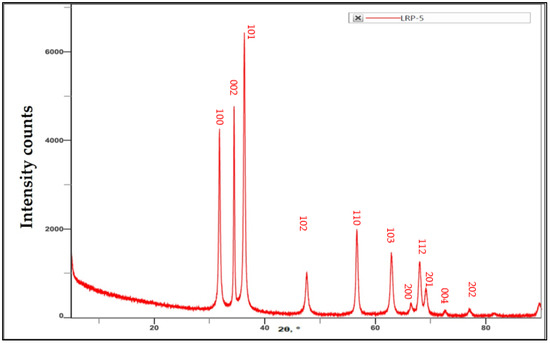
Figure 8.
The X-ray diffraction patterns of ZnO nanoparticles prepared from R. sativus extract.
Based on the prominent peak associated with the (101) plane and the Debye–Scherrer equation, the crystal size of the ZnONPs was determined. The size of the particles in ZnONPs was calculated using Debye–Scherrer’s formula to be 66.47 nm [15,16,17,18]. Debye–Scherrer’s equation was used to calculate the crystal size of ZnONPs based on the intense peak corresponding to the (101) plane.
D = 0.89/(cos), where D represents crystal size, X-ray wavelength, i.e., 1.5406 Ao, FWHM (Full Width at Half Maximum) of the peak centred at 2 = 36.25o, and Bragg’s angle of diffraction [26]. The particle size of the ZnONPs was determined to be 66.47 nm using Debye–Scherrer’s formula.
3.8. Antibacterial Activity
Because of its exceptional qualities, including a large specific surface area and strong activity to block a variety of pathogenic agents, ZnONPs can be chosen as an antibacterial material. However, as of late, little is known about ZnONPs’ antimicrobial properties. Previous studies have suggested that ZnONPs’ primary antibacterial toxicity mechanisms were based on their capacity to stimulate excessive ROS formation, including the synthesis of superoxide anion, hydroxyl radicals, and hydrogen peroxide. The antibacterial activity may include the buildup of ZnONPs in the bacterial cells’ cytoplasm or outer membrane, which would lead to Zn2+ release and result in membrane disintegration, protein degradation, and genetic instability that would kill the bacterium. The antibacterial assay findings, which are depicted in Figure 9, showed that ZnONPs (10 mg/mL) were effective against all six test bacteria to varying degrees, with zones of inhibition that ranged in diameter from 12 mm to 19 mm, as indicated in Table 4.
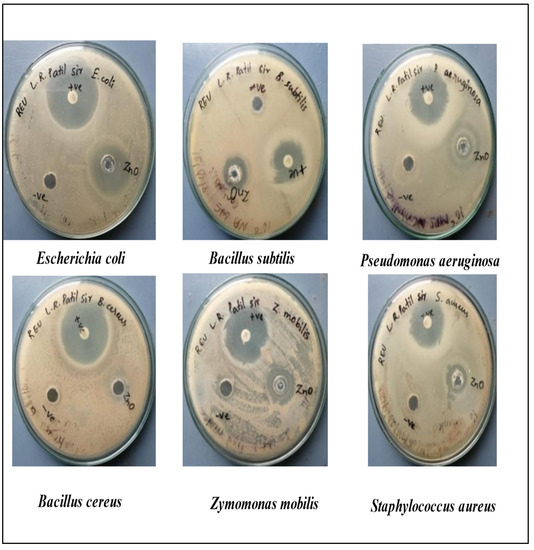
Figure 9.
Antibacterial activity of ZnONPs on Gram-positive and Gram-negative bacteria.

Table 4.
Antibacterial activity with a zone of inhibition (mm).
The results indicated that the nanoparticles were effective against both Gram-positive and Gram-negative bacteria. The zone of inhibition ranged from 12 mm (B. cereus) to 19 mm (E. coli). This is in line with several studies conducted with nanoparticles against different bacteria [27]. No antibacterial activity was observed when the negative control was used as the vehicle control (water without nanoparticles), reflecting that the antibacterial activity demonstrated was due to the action of nanoparticles alone. Gram-positive bacteria were shown to be more resilient to the nanoparticles than Gram-negative bacteria (Table 4). Similar outcomes have been reported in a number of earlier publications [28,29]. The variation in the two types of bacteria’s cell wall composition is thought to be responsible for the phenomena [30,31,32,33,34,35,36,37,38].
3.9. Cytotoxicity by MTT Assay
The cytotoxic potential of the synthesized ZnONPs on human breast cancer cells (MCF-7) has been examined using an MTT assay [39,40,41,42]. The cells were exposed to various concentrations of plant extract (PE) and AGNP nanoparticles for 48 h. The inhibitory concentration (IC50 value) of PE, AGNP, and doxorubicin were 95.43 ± 4.2, 8.05 ± 1.65, and 3.33 ± 0.15 μg/mL, respectively. There are no significant differences observed in ZnONP and doxorubicin at all concentrations except at 3.125 μg/mL. The MTT results showed that the ZnONPs decreased cell viability dose-dependently, as shown in Figure 10.
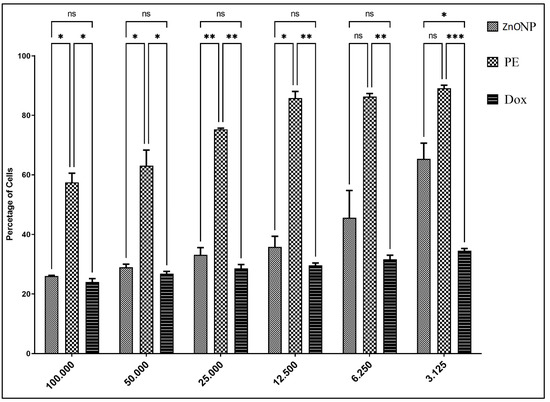
Figure 10.
The Cytotoxicity PE, ZnONPs, and Doxorubicin using MTT assay. [The difference was regarded as significant when * p < 0.05 significant, ** p < 0.01 moderately significant, *** p < 0.001 highly significant].
3.10. Apoptosis Assay by Flowcytometry
We performed the apoptosis using a flow cytometer [43]. The results showed that the PE and ZnONP samples induced apoptosis. When compared with untreated cells, the ZnONP-treated cells significantly decreased the live cells. Similarly, the ZnONP-treated cells significantly increased the early and late apoptosis significantly in comparison to the PE-treated cells shown in Figure 11.
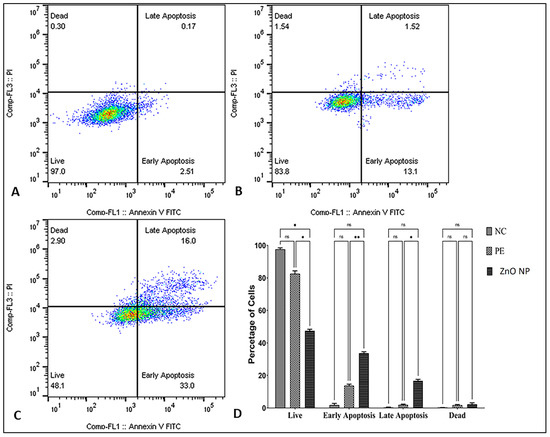
Figure 11.
Apoptotic by flow cytometer in PR and ZnONP on MCF cells (A) Untreated control cells, (B) Cells treated with PE, (C) Cells treated with AGNP. (D) Bar graph for apoptosis.
3.11. Cell Cycle Analysis by Flow Cytometer
The effect of PE and ZnONP-treated MCF cells on cell cycle progression was analyzed by flow cytometer after exposure to a concentration of IC50 for 12 h. Compared to the untreated cells [39,40,41], PE and ZnONPs-treated cells decreased the G1 phase cells from 77.95 ± 0.91 to 74.08 ± 1.2 and 73.6 ± 1.13, respectively, which is not significant. Similarly, there are no signifying changes in the S phase and G2 phases in PE and ZnONPs-treated MCF cells, as shown in Figure 12.
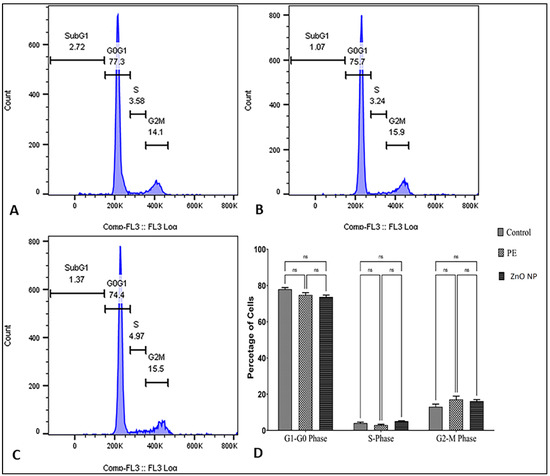
Figure 12.
Cell Cycle Analysis by flow cytometer in PE and ZnONPs-treated MCF cells (A) Untreated control cells, (B) Cells treated with PE, (C) Cells treated with ZnONPs. (D) Bar graph for cell cycle arrest.
An MTT assay was used to measure the cytotoxicity of PE and ZnONPs. The cytotoxic properties of the ZnONPs are due to their ability to react with proteins and DNA. Soodabeh Darvish et al. proved that green synthesized nanoparticles from Ducrosia Anethifolia showed cytotoxicity with an IC50 value of 36.56 ± 2.29 against MCF-7 [44]. The Tamarindus indica fruit-shell extract mediated biosynthesis of ZnONP showed a dose-dependent cytotoxic effect against MCF-7 cells, with the IC50 found to be 20 μg/mL [45].
ZnONPs interact with cellular proteins and DNA, resulting in ROS generation and a reduction in the glutathione (SGH) level, the activation of nuclear factor kB (NF-kB), and tumor necrosis factor-alpha (TNF-α). The increase in ROS alters the mitochondrial transmembrane potential and disturbs the signal transduction pathway, which triggers apoptosis and cell death [46]. Berehu et al., 2021, reported that ZnONPs synthesized from Swertia chirayita significantly (p < 0.05) increased the proportion of cells that underwent apoptosis and necrosis compared to that in the control cells post 24 h of exposure [47,48,49,50].
In the current investigation, the PE and ZnONPs samples-treated cells exhibited significant cell cycle arrest, which could be attributed to their particular advantages such as biocompatibility, lower toxicity, superior stability, higher permeability, retention effect, and precise targeting.
4. Conclusions
An eco-friendly, simple, and effective technique for the rapid biological manufacture of zinc oxide nanoparticles is R. sativus leaf extract. This technology has been used to successfully produce zinc oxide nanoparticles. UV-Visible spectrophotometer, SEM-EDS, XRD, and FTIR methods were used to characterize the produced zinc oxide nanoparticles. The SEM picture revealed that the majority of the nanoparticles are spherical. The creation of a hexagonal wurtzite crystal structure with a dimension of 66.47 nm, as estimated by Debye Scherrer’s equation, was confirmed by X-ray diffraction. The synthesized ZnONPs demonstrated antibacterial effectiveness. The highest inhibition zone was observed for E Coli using the agar-well diffusion method. This procedure of green synthesis is a cost-effective way to make nanocrystalline zinc oxide. Collectively, our data suggest that the ZnONPs of R. sativus leaf extract inhibit breast cancer cell lines with significant cytotoxic action. The ZnONPs are, therefore, a prospective source of chemopreventive drugs that merit additional exploration in order to uncover lead compounds with cancer chemotherapeutic potential. ZnONPs have demonstrated promising medicinal properties. Due to their inherent toxicity, ZnONPs have the potential to be used as anticancer and antibacterial treatments since they have substantial inhibitory effects against bacteria and malignant cells by causing intracellular ROS generation and activating the apoptotic signaling pathway.
Author Contributions
Conceptualization, A.R.S., L.R.P. and U.M.M.; Data curation, R.N., S.V.D., S.A. and V.S.H.; Formal analysis, L.R.P., M.H.M., S.V.D., U.M.M. and V.K.; Funding acquisition, A.A.A.A., I.A.S., M.H.M. and H.S.M.G.; Investigation, A.R.S., S.V.D., V.S.H., A.A.K., S.M.S.I. and V.K.; Methodology, A.A.A.A., M.M.A., R.N. and H.S.M.G.; Project administration, A.R.S., I.A.S. and S.M.S.I.; Resources, M.M.A. and A.A.K.; Supervision, L.R.P.; Validation, S.A.; Visualization, R.N.; Writing—original draft, L.R.P., U.M.M. and S.A.; Writing—review & editing, A.A.A.A., I.A.S., M.M.A., M.H.M., V.S.H., A.A.K., H.S.M.G., S.M.S.I. and V.K. All authors have read and agreed to the published version of the manuscript.
Funding
The authors are thankful to the Deanship of Scientific Research, Najran University, Najran, Saudi Arabia, for funding this research through grant research code NU/NAR/MRC/11/10.
Institutional Review Board Statement
Not applicable.
Informed Consent Statement
Not applicable.
Data Availability Statement
The data used to support the findings of this study are available from the corresponding author upon request.
Acknowledgments
The authors are thankful to Najran University, Najran, Saudi Arabia; and Department of Biotechnology, KLE Technological University, BVB Campus, Hubballi, India; for supporting steps of this work.
Conflicts of Interest
The authors declare no conflict of interest.
References
- Albrecht, M.A.; Evans, C.W.; Raston, C.L. Green Chemistry and the Health Implications of Nanoparticles. Green Chem. 2006, 8, 417–432. [Google Scholar] [CrossRef]
- Singh, P.; Kim, Y.J.; Zhang, D.; Yang, D.C. Biological Synthesis of Nanoparticles from Plants and Micromicroorganisms. Trends Biotechnol. 2016, 34, 588–599. [Google Scholar] [CrossRef]
- Rouhi, J.; Mahmud, S.; Naderi, N.; Ooi, C.; Mahmood, M.R. Physical Properties of Fish Gelatin-Based Bio-nanocomposite Films Incorporated with ZnO Nanorods. Nanoscale Res. Lett. 2013, 8, 364. [Google Scholar] [CrossRef]
- Tiwari, V.; Mishra, N.; Gadani, K.; Solanki, P.S.; Shah, N.A.; Tiwari, M. Mechanism of Anti-bacterial Activity of Zinc Oxide Nanoparticle against Carbapenem-Resistant Acinetobacter baumannii. Front. Microbiol. 2018, 9, 1218. [Google Scholar] [CrossRef]
- Chaudhuri, S.K.; Malodia, L. Biosynthesis of Zinc Oxide Nanoparticles Using Leaf Extract of Calotropis gigantea: Characterization and Its Evaluation on Tree Seedling Growth in Nursery Stage. Appl. Nanosci. 2017, 7, 501–512. [Google Scholar] [CrossRef]
- Bi, C.; Li, J.; Peng, L.; Zhang, J. Biofabrication of Zinc Oxide Nanoparticles and Their In-Vitro Cytotoxicity Towards Gastric Cancer (MGC803). Cell. Biomed. Res. 2017, 28, 2065–2069. [Google Scholar]
- Zheng, Y.; Fu, L.; Han, F.; Wang, A.; Cai, W.; Yu, J.; Yang, J.; Peng, F. Green Biosynthesis and Characterization of Zinc Oxide Nanoparticles Using Corymbia Citriodora Leaf Extract and Their Photocatalytic Activity. Green Chem. Lett. Rev. 2015, 8, 59–63. [Google Scholar] [CrossRef]
- Manokari, M.; Shekhawat, M.S. Green synthesis of zinc oxide nanoparticles using whole plant extracts of Cassia tora L. and their characterization. J. Sci. Achiev. 2017, 2, 10–16. [Google Scholar]
- Khalil, A.T.; Ovais, M.; Ullah, I.; Ali, M.; Shinwari, Z.K.; Khamlich, S.; Maaza, M. Sageretiathea (Osbeck.) Mediated Synthesis of Zinc Oxide Nanoparticles and Its Biological Applications. Nanomedicine 2017, 12, 1767–1789. [Google Scholar] [CrossRef]
- Anbuvannan, M.; Ramesh, M.; Viruthagiri, G.; Shanmugam, N.; Kannadasan, N. Anisochilus carnosus Leaf Extract Mediated Synthesis of Zinc Oxide Nanoparticles for Antibacterial and Photocatalytic Activities. Mater. Sci. Semicond. Process. 2015, 39, 621–628. [Google Scholar] [CrossRef]
- Raj, L.F.A.; Jayalakshmy, E. Biosynthesis and Characterization of Zinc Oxide Nanoparticles Using Root Extract of Zingiber officinale. Orient. J. Chem. 2015, 31, 51–56. [Google Scholar] [CrossRef]
- Bhuyan, T.; Mishra, K.; Khanuja, M.; Prasad, R.; Varma, A. Biosynthesis of Zinc Oxide Nanoparticles from Azadirachta indica for Antibacterial and Photocatalytic Applications. Mater. Sci. Semicond. Process. 2015, 32, 55–61. [Google Scholar] [CrossRef]
- Bala, N.; Saha, S.; Chakraborty, M.; Maiti, M.; Das, S.; Basu, R.; Nandy, P. Green Synthesis of Zinc Oxide Nanoparticles Using Hibiscus Subdariffa Leaf Extract: Effect of Temperature on Synthesis, Anti-bacterial Activity and Anti-diabetic Activity. RSC Adv. 2015, 5, 4993–5003. [Google Scholar] [CrossRef]
- Umamaheswari, A.; Prabu, S.L.; John, S.A.; Puratchikody, A. Green Synthesis of Zinc Oxide Nanoparticles Using Leaf Extracts of Raphanus sativus var. Longipinnatus and Evaluation of Their Anticancer Property in A549 Cell Lines. Biotechnol. Rep. 2021, 29, e00595. [Google Scholar] [CrossRef]
- Francis, S.; Joseph, S.; Koshy, E.P.; Mathew, B. Microwave Assisted Green Synthesis of Silver Nanoparticles Using Leaf Extract of Elephantopus Scaber and Its Environmental and Biological Applications. Artif. Cells Nanomed. Biotechnol. 2018, 46, 795–804. [Google Scholar] [CrossRef] [PubMed]
- Shaikh, I.A.; Muddapur, U.M.; Bagewadi, Z.K.; Chiniwal, S.; Ghoneim, M.M.; Mahnashi, M.H.; Alsaikhan, F.; Yaraguppi, D.; Niyonzima, F.N.; More, S.S.; et al. Characterization of Bioactive Compounds from Acacia concinna and Citrus limon, Silver Nanoparticles’ Production by A. concinna Extract, and Their Biological Properties. Molecules 2022, 27, 2715. [Google Scholar] [CrossRef]
- Kokate, C.K.; Purohit, A.P.; Gokhale, S.B. Pharmacognosy, 47th ed.; Nirali Prakashan Publication: Pune, India, 2011. [Google Scholar]
- Gupta, M.; Tomar, R.S.; Kaushik, S.; Mishra, R.K.; Sharma, D. Effective Antimicrobial Activity of Green ZnO Nano Particles of Catharanthus Roseus. Front. Microbiol. 2018, 9, 2030. [Google Scholar] [CrossRef]
- Jeeva Lakshmi, V.; Sharath, R.; Chandraprabha, M.N.; Neelufar, E.; Hazra, A.; Patra, M. Synthesis, Characterization and Evaluation of Antimicrobial Activity of Zinc Oxide Nanoparticles. J. Biochem. Technol. 2012, 3, S151–S154. [Google Scholar]
- Weng, X.; Guo, M.; Luo, F.; Chen, Z. One-Step Green Synthesis of Bimetallic Fe/Ni Nanoparticles by Eucalyptus Leaf Extract: Biomolecules Identification, Characterization and Catalytic Activity. Chem. Eng. J. 2017, 308, 904–911. [Google Scholar] [CrossRef]
- Demissie, M.G.; Sabir, F.K.; Edossa, G.D.; Gonfa, B.A. Synthesis of Zinc Oxide Nanoparticles Using Leaf Extract of Lippia Adoensis (Koseret) and Evaluation of Its Antibacterial Activity. J. Chem. 2020, 2020, 7459042. [Google Scholar] [CrossRef]
- Zak, K.A.; Yousefi, R.; Majid, W.H.A.; Muhamad, M.R. Facile synthesis and X-ray peak broadening studies of Zn1 − xMgxO nanoparticles. Ceram. Int. 2012, 38, 2059–2064. [Google Scholar]
- Kavitha, M.K.; John, H.; Gopinath, P.; Philip, R. Synthesis of reduced graphene oxide–ZnO hybrid with enhanced optical limiting properties. J. Mater. Chem. C Mater. Opt. Electron. Devices 2013, 1, 3669–3676. [Google Scholar] [CrossRef]
- Khan, A.K.; Renouard, S.; Drouet, S.; Blondeau, J.-P.; Anjum, I.; Hano, C.; Abbasi, B.H.; Anjum, S. Effect of UV Irradiation (A and C) on Casuarina equisetifolia-Mediated Biosynthesis and Characterization of Antimicrobial and Anticancer Activity of Biocompatible Zinc Oxide Nanoparticles. Pharmaceutics 2021, 13, 1977. [Google Scholar] [CrossRef]
- Talam, S.; Karumuri, S.R.; Gunnam, N. Synthesis, characterization, and spectroscopic properties of ZnO nanoparticles. Int. Sch. Res. Not. 2012, 2012, 372505. [Google Scholar] [CrossRef]
- Vijayalakshmi, R.; Rajendran, V. Synthesis and characterization of nano-TiO2 via different methods. Arch. Appl. Sci. Res. 2012, 4, 1183–1190. [Google Scholar]
- Shah, R.; Parmar, K.; Vaghela, H. Analysing Antibacterial Efficacy of Biosynthesized Palladium Nanoparticles Using Aqueous Leaf Extract of Cocculus hirsutus As The Reducing Agent. Biosc. Biotech. Res. Commun. 2021, 14. [Google Scholar] [CrossRef]
- Slavin, Y.N.; Asnis, J.; Häfeli, U.O.; Bach, H. Metal Nanoparticles: Understanding the Mechanisms behind Antibacterial Activity. J. Nanobiotechnology 2017, 15, 65. [Google Scholar] [CrossRef]
- Yousef, J.M.; Danial, E.N. In Vitro Antibacterial Activity and Minimum Inhibitory Concentration of Zinc Oxide and Nano-Particle Zinc Oxide against Pathogenic Strains. Int. J. Health Sci. 2012, 2, 38–42. [Google Scholar] [CrossRef]
- Senthilkumar, N.; Nandhakumar, E.; Priya, P.; Soni, D.; Vimalan, M.; Vetha Potheher, I. Synthesis of ZnO nanoparticles using leaf extract of Tectona grandis (L.) and their anti-bacterial, anti-arthritic, anti-oxidant and in vitro cytotoxicity activities. New J. Chem. 2017, 41, 10347–10356. [Google Scholar] [CrossRef]
- Yedurkar, S.; Maurya, C.; Mahanwar, P. Biosynthesis of Zinc Oxide Nanoparticles Using Ixora coccinea Leaf Extract—A Green Approach. Open J. Synth. Theor. Appl. 2016, 5, 1–14. [Google Scholar] [CrossRef]
- Nour El Din, S.; El-Tayeb, T.A.; Abou-Aisha, K.; El-Azizi, M. In Vitro and in Vivo Antimicrobial Activity of Combined Therapy of Silver Nanoparticles and Visible Blue Light against Pseudomonas Aeruginosa. Int. J. Nanomed. 2016, 11, 1749–1758. [Google Scholar] [CrossRef]
- Janaki, A.C.; Sailatha, E.; Gunasekaran, S. Synthesis, Characteristics and Antimicrobial Activity of ZnO Nanoparticles. Spectrochim. Acta A Mol. Biomol. Spectrosc. 2015, 144, 17–22. [Google Scholar] [CrossRef]
- Wang, L.L.; Hu, C.; Shao, L.Q. The Antimicrobial Activity of Nanoparticles: Present Situation and Prospects for the Future. Int. J. Nanomed. 2017, 12, 1227–1249. [Google Scholar] [CrossRef]
- Ravichandran, A.; Subramanian, P.; Manoharan, V.; Muthu, T.; Periyannan, R.; Thangapandi, M.; Ponnuchamy, K.; Pandi, B.; Marimuthu, P.N. Phyto-Mediated Synthesis of Silver Nanoparticles Using Fucoidan Isolated from Spatoglossum Asperum and Assessment of Antibacterial Activities. J. Photochem. Photobiol. B 2018, 185, 117–125. [Google Scholar] [CrossRef] [PubMed]
- Mohanta, Y.K.; Panda, S.K.; Jayabalan, R.; Sharma, N.; Bastia, A.K.; Mohanta, T.K. Antimicrobial, Antioxidant and Cytotoxic Activity of Silver Nanoparticles Synthesized by Leaf Extract of Erythrina Suberosa (Roxb.). Front. Mol. Biosci. 2017, 4, 14. [Google Scholar] [CrossRef]
- Paulkumar, K.; Gnanajobitha, G.; Vanaja, M.; Rajeshkumar, S.; Malarkodi, C.; Pandian, K.; Annadurai, G. Piper Nigrum Leaf and Stem Assisted Green Synthesis of Silver Nanoparticles and Evaluation of Its Antibacterial Activity against Agricultural Plant Pathogens. Sci. World J. 2014, 2014, 829894. [Google Scholar] [CrossRef]
- Sharmila, G.; Muthukumaran, C.; Sandiya, K.; Santhiya, S.; Pradeep, R.S.; Kumar, N.M.; Suriyanarayanan, N.; Thirumarimurugan, M. Biosynthesis, Characterization, and Antibacterial Activity of Zinc Oxide Nanoparticles Derived from Bauhinia tomentosa Leaf Extract. J. Nanostruct. Chem. 2018, 8, 293–299. [Google Scholar] [CrossRef]
- Bhagwat, D.A.; Swami, P.A.; Nadaf, S.J.; Choudhari, P.B.; Kumbar, V.M.; More, H.N.; Killedar, S.G.; Kawtikwar, P.S. Capsaicin Loaded Solid SNEDDS for Enhanced Bioavailability and Anticancer Activity: In-Vitro, in-Silico, and in-Vivo Characterization. J. Pharm. Sci. 2021, 110, 280–291. [Google Scholar] [CrossRef]
- Pozarowski, P.; Grabarek, J.; Darzynkiewicz, Z. Flow Cytometry of Apoptosis. Curr. Protoc. Cell Biol. 2003, 21, 18.8.1–18.8.33. [Google Scholar] [CrossRef]
- Kumbar, V.M.; Muddapur, U.M.; Bhat, K.G.; Shwetha, H.R.; Kugaji, M.S.; Peram, M.R.; Dindawar, S. Cancer Stem Cell Traits in Tumor Spheres Derived from Primary Laryngeal Carcinoma Cell Lines. Contemp. Clin. Dent. 2021, 12, 247–254. [Google Scholar] [CrossRef] [PubMed]
- Muddapur, U.M.; Alshehri, S.; Ghoneim, M.M.; Mahnashi, M.H.; Alshahrani, M.A.; Khan, A.A.; Iqubal, S.M.S.; Bahafi, A.; More, S.S.; Shaikh, I.A.; et al. Plant-Based Synthesis of Gold Nanoparticles and Theranostic Applications: A Review. Molecules 2022, 27, 1391. [Google Scholar] [CrossRef]
- Alyamani, A.A.; Albukhaty, S.; Aloufi, S.; AlMalki, F.A.; Al-Karagoly, H.; Sulaiman, G.M. Green Fabrication of Zinc Oxide Nanoparticles Using Phlomis Leaf Extract: Characterization and In Vitro Evaluation of Cytotoxicity and Antibacterial Properties. Molecules 2021, 26, 6140. [Google Scholar] [CrossRef]
- Abdallah, Y.; Liu, M.; Ogunyemi, S.O.; Ahmed, T.; Fouad, H.; Abdelazez, A.; Yan, C.; Yang, Y.; Chen, J.; Li, B. Bioinspired Green Synthesis of Chitosan and Zinc Oxide Nanoparticles with Strong Antibacterial Activity against Rice Pathogen Xanthomonas oryzae pv. oryzae. Molecules 2020, 25, 4795. [Google Scholar] [CrossRef] [PubMed]
- Daneshvar, N.; Aber, S.; Dorraji, M.S.S.; Khataee, A.R.; Rasoulifard, M.H. Photocatalytic degradation of the insecticide diazinon in the presence of prepared nanocrystalline ZnO powders under irradiation of UV-C light. Sep. Purif. Technol. 2007, 58, 91–98. [Google Scholar] [CrossRef]
- Darvish, S.; Kahrizi, M.S.; Özbolat, G.; Khaleghi, F.; Mortezania, Z.; Sakhaei, D. Silver nanoparticles: Biosynthesis and cytotoxic performance against breast cancer MCF-7 and MDA-MB-231 cell lines. Nanomed. Res. J. 2022, 7, 83–92. [Google Scholar] [CrossRef]
- Gomathi, A.C.; Rajarathinam, S.X.; Sadiq, A.M.; Rajeshkumar, S. Anticancer activity of silver nanoparticles synthesized using aqueous fruit shell extract of Tamarindus indica on MCF-7 human breast cancer cell line. J. Drug Deliv. Sci. Technol. 2020, 55, 101376. [Google Scholar] [CrossRef]
- Gurunathan, S.; Han, J.W.; Eppakayala, V.; Jeyaraj, M.; Kim, J.H. Cytotoxicity of biologically synthesized silver nanoparticles in MDA-MB-231 human breast cancer cells. Biomed. Res. Int. 2013, 2013, 535796. [Google Scholar] [CrossRef]
- Berehu, H.M.; Anupriya, S.; Khan, M.I.; Chakraborty, R.; Lavudi, K.; Penchalaneni, J.; Mohapatra, B.; Mishra, A.; Patnaik, S. Cytotoxic Potential of Biogenic Zinc Oxide Nanoparticles Synthesized from Swertia Chirayita Leaf Extract on Colorectal Cancer Cells. Front. Bioeng. Biotechnol. 2021, 9, 788527. [Google Scholar] [CrossRef] [PubMed]
- El-Naggar, N.E.; Hussein, M.H.; El-Sawah, A.A. Bio-fabrication of silver nanoparticles by phycocyanin, characterization, in vitro anticancer activity against breast cancer cell line and in vivo cytotxicity. Sci. Rep. 2017, 7, 10844. [Google Scholar] [CrossRef] [PubMed]
Publisher’s Note: MDPI stays neutral with regard to jurisdictional claims in published maps and institutional affiliations. |
© 2022 by the authors. Licensee MDPI, Basel, Switzerland. This article is an open access article distributed under the terms and conditions of the Creative Commons Attribution (CC BY) license (https://creativecommons.org/licenses/by/4.0/).